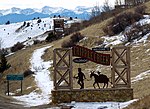Gold Belt Tour Scenic and Historic Byway
Back Country Byways in ColoradoBureau of Land Management Back Country BywaysColorado Scenic and Historic BywaysFlorissant Fossil Beds National MonumentInfobox road instances in Colorado ... and 12 more
Infobox road maps tracking categoryInfobox road temporary tracking category 1National Scenic BywaysNational Scenic Byways in ColoradoTourist attractions in ColoradoTourist attractions in Fremont County, ColoradoTourist attractions in Teller County, ColoradoTransportation in ColoradoTransportation in Fremont County, ColoradoTransportation in Teller County, ColoradoU.S. Route 24U.S. Route 50
The Gold Belt Tour Scenic and Historic Byway is a National Scenic Byway, a Back Country Byway, and a Colorado Scenic and Historic Byway located in Fremont and Teller counties, Colorado, USA. The byway is named for the Gold Belt mining region. The Cripple Creek Historic District is a National Historic Landmark. The byway forms a three-legged loop with the Phantom Canyon Road (narrow gravel), the Shelf Road (narrow unimproved), and the High Park Road (paved).
Excerpt from the Wikipedia article Gold Belt Tour Scenic and Historic Byway (License: CC BY-SA 3.0, Authors).Gold Belt Tour Scenic and Historic Byway
East Bennett Avenue,
Geographical coordinates (GPS) Address Nearby Places Show on map
Geographical coordinates (GPS)
| Latitude | Longitude |
|---|---|
| N 38.7466 ° | E -105.1784 ° |
Address
East Bennett Avenue 172
80813
Colorado, United States
Open on Google Maps









